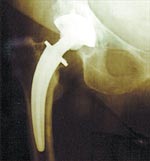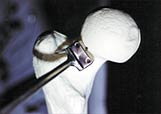Instruments aid accuracy of THR done through a minimally invasive incision
The system is universal and permits precise bone cuts and component alignment.
NEW ORLEANS — Developers of a keyhole total hip replacement procedure said the minimally invasive technique ensures accurate component positioning and permits patients to rehabilitate quickly.
Since the hip is not dislocated during surgery, ligaments and muscles are minimally disturbed and morbidity is reduced, according to the developers, who have used it to treat 58 patients.
The technique is indicated for primary total hip replacement (THR) in patients with osteoarthritis, rheumatoid arthritis or osteonecrosis. It is contraindicated in obese patients or when a posterolateral approach is contraindicated, or where there is severe deformity of the femoral head or neck.
Use of this THR technique is still in the early stages — the longest follow-up is 18 months — but average Harris Hip Scores of 30 preoperatively increased to 87 postoperatively, the Australian developers said.
Great expectations
Because the early results are promising and since most hip surgeons can readily learn the technique — usually after about four hours of training and performing five cases — developers are optimistic about how the technique may change the way THR is performed in the future.
 --- This radiograph taken at 18 months postop is of a 72-year-old female patient whose total hip replacement prosthesis was implanted using the minimally invasive NILNAV system. She received an uncemented LINK C.F.P. stem with a T.O.P. acetabular implant fixed with one screw.
--- This radiograph taken at 18 months postop is of a 72-year-old female patient whose total hip replacement prosthesis was implanted using the minimally invasive NILNAV system. She received an uncemented LINK C.F.P. stem with a T.O.P. acetabular implant fixed with one screw.
COURTESY OF EUGENE SHERRY
The technique is performed using a patented navigationless instrument system called the NILNAV Hip System. Most patients only require a single 5- to 7-cm posterolateral incision behind the greater trochanter, but overweight patients may require a 10-cm incision. “In 10% of cases, I extend the incision 2 to 4 cm. The instruments also allow you to do a much more accurate operation no matter what the length of the incision,” according to Eugene Sherry, MD, FRACS, of Sydney Private Hospital. He developed the system with engineer Michael Egan.
Sherry presented preliminary results using the system in a poster presentation during the American Academy of Orthopaedic Surgeons 70th Annual Meeting in New Orleans.
Universal system
The developers are hoping orthopedic surgeons worldwide will accept the NILNAV Hip System because it is universal.
 ---
The system’s cutting block was designed to cut the femoral neck without dislocating the hip at the procedure’s start.
---
The system’s cutting block was designed to cut the femoral neck without dislocating the hip at the procedure’s start.
It works with several manufacturers’ models of cemented or cementless hip prostheses. Sherry has used the NILNAV system for THR using cementless as well as cemented stems and cups, such as Link’s uncemented C.F.P. stem and pressfit T.O.P. acetabular cup and Howmedica’s ABG hip.
The technique does not require intraoperative imaging or a surgical navigation system. Instead, a precision tool kit allows the surgeon to exactly locate the femoral neck and then cut it using a cutting block. A jig system ensures accurate orientation of the acetabular cup in relationship to the stem.
 ---
A special Z bone compressor in the NILNAV instrument set is used to make the final opening of the femoral canal. The stem curvature identified during preoperative planning determines which compressor will be used during surgery.
---
A special Z bone compressor in the NILNAV instrument set is used to make the final opening of the femoral canal. The stem curvature identified during preoperative planning determines which compressor will be used during surgery.
“Before, this was always done in an arbitrary manner. Now the cup can only be placed in one position,” Sherry said. Proper cup orientation typically reduces component dislocation, maltracking and long-term wear. Part of the jig system is an alignment device called a lollipop, which is held perpendicular to the table. The acetabular cup is attached to the lollipop and then impacted in the proper position.
Soft tissue tensioning is practically foolproof by adding up to two spacers to the lollipop, which “allow the right soft tissue tension to be determined and [provide] a final check of the orientation of the cup relative to the stem,” he said. Spacers also help the surgeon avoid doing multiple trial reductions.
Less cone dissection
The technique is much less invasive, Sherry said, as cone dissection is 96% less than is typically necessary with traditional THR procedures. Because it produces less pain, a smaller scar and faster rehabilitation, patients prefer this surgery, he added. On average, patients are discharged from the hospital two days after surger, and most require just two postoperative physical therapy sessions. “I recently did a 98-year-old man who was walking the next day,” he told Orthopedics Today.
At least 20 orthopedic surgeons from Australia, New Zealand, Malaysia and the United States are currently being trained to perform the technique.
Dr. Sherry has a financial interest in the NILNAV system.
For your information:
- Sherry E, Sivananthan DKS, Sivananthan S, et al. Minimal invasive surgery for hip replacement using the NILNAV Hip System. Poster #512. Presented at the American Academy of Orthopaedic Surgeons 70th Annual Meeting. Feb. 5-9, 2003. New Orleans.
- Sherry E, Egan M, Henderson A, Warnke PH. Minimal invasive hip replacement using the SE Hip System. Presented at the 62nd Annual Scientific Meeting of the Australian Orthopaedic Association. Oct. 13-18, 2002. Melbourne.
